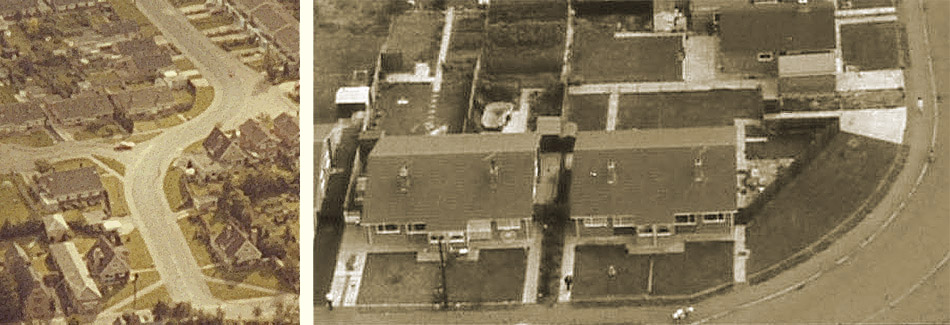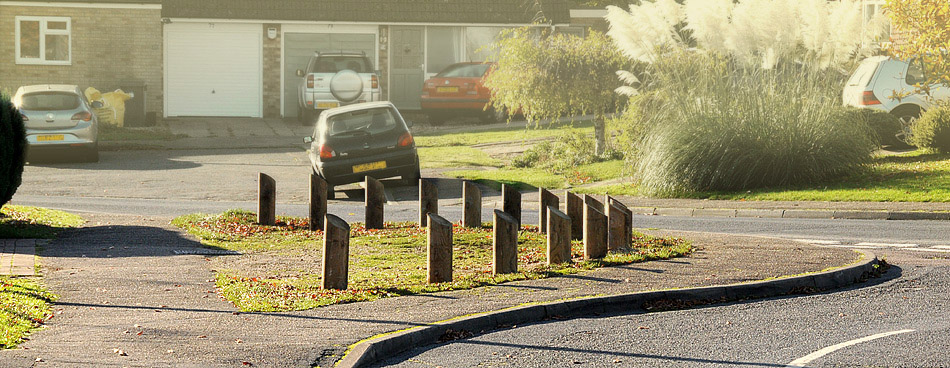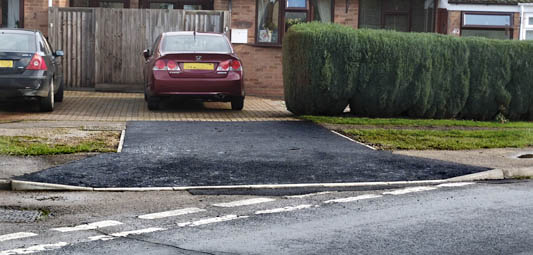|
The Blisworth Post-henge, AD 2012 Back in the mists of the 1960s an overworked architect laid out the K. G. Laurence and Wilson housing estates that were to fill the space between the Stoke Road and Connegar Leys. The housing was considered to conform to "budget" and to cater for a wide range of families so there were included both detached, semi-detached and terraced houses and quite a few semi-detached bungalows, also a small number of detached bungalows. In a number of cases, especially for some bungalows and some terraced houses, a garage for the residents was included in a group of garages at some small distance. In one case, there was provided room for the garage and there was a short drive and kerbstone dropdown (drop-kerb) but the provision of the garage was left for an incoming owner to provide. This was probably a feature that was attractive to a few not-so-well-off or retired folk, at least that was the case in the 1960s but such a provision nowadays would be considered anachronistic.
The image on the left, above, shows the lower 200 yard section of Buttmead, as it was in ~1970. The image on the right gives more detail so that access provision for each of these four bungalows can be viewed reasonably clearly. The bungalow to the left has a twin strip of concrete to serve as a drive and a drop-kerb on Eastfield (as in the view in the left-hand image). There is no garage but there is room for one behind the house. The next three bungalows just had a single strip of concrete to serve as a path to the house and no provision of a drop-kerb. Instead there is a grouping of three spaces for cars around the corner to the right and two have been laid to concrete but one has not. One of the owners had erected a single garage right next door to the first (detached) bungalow on Buttmead. Now fast-forward to the new millenium; the two middle bungalows have extensive pavoired areas and have been parking near their bungalows for years, apparently. They have no drop-kerb because there is an obstacle in the way: there is an intervening "half-moon" of grass (this is visible only in the left-hand image whilst the right hand image was originally cropped that way and does not include this grass). Along comes a NCC Highways team and within one day in October 2012 seventeen heavy posts are planted across the half-moon of grass. The official NCC view of the situation, at the outset, is that the posts were needed to deal with two issues: (i) the grass was being/had been parked upon despite the area being a 'visibility splay' and (ii) the pavement was being driven across. In the absence of a drop-kerb it is illegal to drive across a pavement. Given a drop-kerb it is legal to drive right across the part that is a pedestrian way leaving no part of the vehicle across that way, and not driving in a way liable to endanger the public. The official view of the use of 'driveways' without drop-kerbs may have been more flexible many years ago and an impression of this may have persisted until more recently. The picture below aims to show NCC Highways' creation in wood in as attractive a light as possible but the sad truth, one feels, is that the posts are an abomination, a vulgar signature of our urban society and thoroughly unwelcome at that. But the creation is a result of cavalier elements in society, both in relation to individuals and institutions, and one wonders why the product of the altercation has to be a physical one - oh well!
On reading this article one may wonder why it is included in an 'on-going' history archive. The reason is that the Post-henge may well be a feature of Blisworth that is left in place long after (i). rules or methods have changed or (ii). the initiators have moved away or passed on. In regard to the second contingency, "the posts are permanent", says the NCC, their action evidently being to preserve what is 'highway' for all time. May 1st, 2013 Just about six months after placing the posts, with the rider "for all time...", NCC Highways removed them and set the area to grass. The comments later suggested that it had become well known the posts were "not working" and that other methods should be explored.
November 13th, 2014 With some newcomers in the next door to end bungalow, a recent application for a driveway and drop-kerb was evidently received without objection despite being at the junction of roads, so the corner now has a new look (see inset). This is to be applauded for it now seems that reasonable modernisation of vehicular provisions is allowed and all of us on this 1960s estate may enjoy the "new forward looking" Highways Dept rules.
Tony Marsh |


